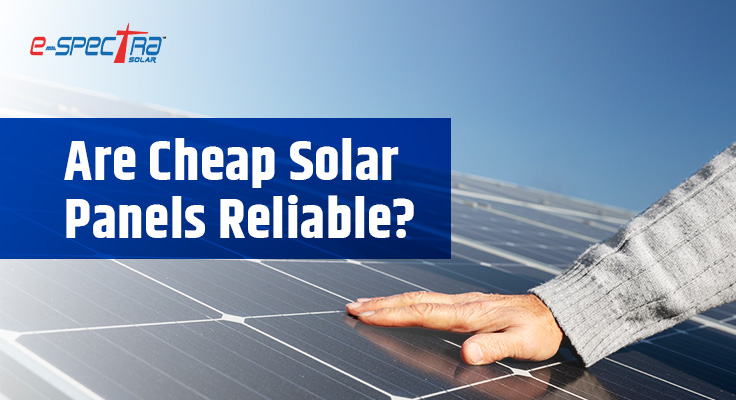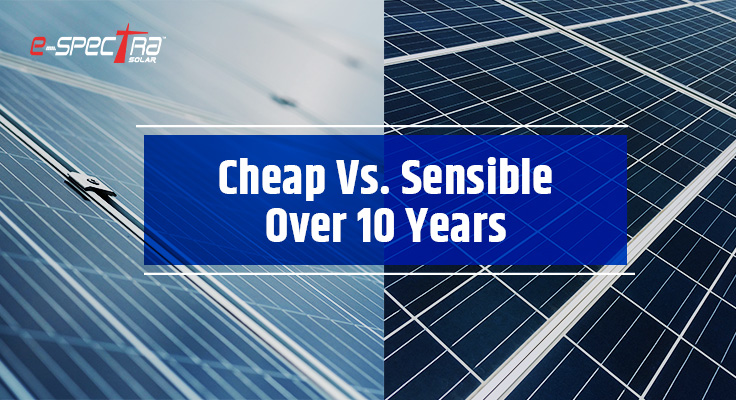Published: 19 Sep, 2025 | By Solar
Electricity bills are rising. Power cuts still happen. Because of this, many people are turning to solar. But the first search people do is often: “cheap solar panels” or “where to buy cheap solar panels.”
Cheap sounds good for the pocket, but is it really smart for the long run? Are you sacrificing reliability? In this guide, we’ll explain everything in plain language, cost, quality, subsidies, saving, and a step-by-step way to get affordable solar energy without getting stuck with poor-quality products. We’ll also tell you how a trusted installer like Spectra Solar Power keeps things simple and safe.
What Do We Really Mean By “Cheap Solar Panels”?
“Cheap” can mean two different things:
- Low price but decent quality (for example, a basic but certified panel from a known brand during a seasonal discount).
- Low price because of low quality (unknown brand, no proper warranty, outdated or damaged stock, or panels without proper certification).
In daily life, we know this: sometimes a “deal” is a deal; sometimes it’s a headache. Solar is similar. The trick is to separate a genuine bargain from a risky purchase.
The Parts That Decide Your Solar Cost (Not Just The Panel)
When people hear “solar,” they think only of the panel. But your system is a small team of important parts:
- Solar panels: The roof players that catch sunlight.
- Inverter: The captain that converts DC (from panels) to AC (for your home).
- Mounting structure: The frame that keeps panels fixed and safe in wind and rain.
- Wiring, conduits, protection devices: The nerves and safety system.
- Net meter (for on-grid) / batteries (for off-grid): The bridge to the grid or your backup power.
- Installation quality & after-sales service: Human skill and support, often the difference between “cheap today” and “costly tomorrow.”
Because of this, system price is not only “panel price.” If you buy a very cheap panel but pair it with a weak inverter or poor installation, performance suffers and the system may fail early.
Are Cheap Solar Panels Reliable?

Short answer: not always.
Reliability depends on a few practical things:
- Certification and testing: In India, look for BIS compliance and panels listed by approved bodies. This indicates basic quality standards.
- Brand track record: If a company is around for years, offers clear warranties, and has local service, that’s a good sign.
- Installer reputation: Even a good panel can underperform if installed badly (wrong tilt, loose wiring, poor earthing).
- Climate toughness: We get heat, dust, rain, and storms. Panels must handle all of this without rapid drop in performance.
Cheap products often skip strict quality checks or use lower-grade materials. That’s why they may start strong, then fade early, giving less electricity each year.
Affordable Solar Energy Vs. “Too Cheap To Be True”
There’s a difference between affordable and suspicious:
- Affordable solar energy: You save money by using subsidies, choosing the right size, picking reliable entry-level components, and buying during genuine offers, without compromising safety and warranty.
- “Too cheap to be true”: Prices far below market, unclear brand, no paperwork, zero after-sales. It might work for some months, but the risk of failure or poor output is high.
Rule of thumb: If a quote is much lower than 2–3 other quotes for the same size and components, ask why. What’s missing?
How To Get Cheap Solar Panels The Right Way?
If you’re searching how to get cheap solar panels but want to stay safe, follow this simple plan:
Step 1: Size it right
Check your last 6–12 months of electricity bills. How many units do you use monthly?
- Small homes: 1–2 kW
- Average homes: 3–5 kW
- Big homes/small offices: 5–10 kW
Step 2: Choose on-grid, off-grid, or hybrid
- On-grid: No batteries, lower cost, supports net-metering, best value for money.
- Off-grid: With batteries for backup, costs more, useful where power cuts are long and frequent.
- Hybrid: Grid + batteries, flexible, but the highest cost.
If your area’s supply is stable, on-grid is the cheapest sensible choice for most families. You can also check details comparison among those on gride vs off grid vs hybrid solar panel before buying.
Step 3: Pick reliable entry-level components
You don’t need “top-top” premium to be safe, choose reputed brands’ basic ranges.
- Panels: Entry-level mono or poly from known brands with proper certifications.
- Inverter: Trust a known brand with service in your city.
- Structure & safety: Don’t compromise here, good structure and protection devices prevent leaks and electrical issues.
Step 4: Use government subsidy to cut the net price
Residential rooftop solar systems may be eligible for central subsidy (and in some states, extra state support). This is the safest way to make solar affordable because you keep quality and reduce the final cost.
Subsidy amounts and rules can change. Always check the official national rooftop solar portal or ask your installer to show you the current scheme before you finalize.
Step 5: Compare 2–3 written quotes
Ask each installer to list panel brand and model, inverter brand and model, structure type, wiring brand/length, protection devices, warranty, net-metering help, and after-sales terms then compare line-by-line.
Cheap Vs. Sensible Over 10 Years

Family A buys the lowest-price system from an unknown seller. The first year it works okay. Second year the inverter fails; the seller doesn’t pick calls. They buy a new inverter. By year 5, generation drops badly; panels have no valid warranty. They spend more on fixes and still lose units every month.
Family B buys an affordable system (not the absolute cheapest) from a reliable installer. They used subsidy, got quality basics, and a clean install. For 10 years, they mostly just clean panels and call support once a year for a check-up. Bills stay low; savings stay high.
Conclusion: Quality + subsidy beats “rock-bottom price” every time.
Are There Times When Cheaper Options Are Okay?
Yes, if they are still certified and backed by a known brand or trustworthy installer. For example:
- A previous-year model at a discount from a reputed supplier.
- A bulk-purchase offer through a housing society or RWAs arranged by a reliable EPC.
- A festival-season price from a known brand with full warranty.
What to avoid: no-bill, no-warranty, no-brand deals. If the seller says, “You’ll get the warranty card later,” walk away.
If your goal is maximum savings at minimum cost, start with on-grid solar system. If you must have backup, discuss hybrid options with your installer and understand battery replacement timelines.
A Quick Checklist To Avoid Costly Mistakes
- Don’t chase the lowest number blindly. Ask what brands and protections are included.
- Check certifications and warranty. Keep copies of invoices and warranty cards.
- Ask for a roof layout. Confirm panel tilt, spacing, and shading plan.
- Insist on safety gear. Proper earthing, DC/AC isolators, surge protection.
- Plan cleaning. Dust cuts output. A simple water wash and soft brush work.
- Know your service contact. Have a clear AMC or at least a yearly inspection plan.
The Bottom Line
- Cheap is not always affordable.
- A good, basic system + official subsidy usually beats a rock-bottom, no-brand deal.
- Focus on safety, certification, neat installation, and after-sales, that’s what keeps your savings steady for the next 15–20 years.
- If you want a smooth experience, right sizing, paperwork help, and clean install, talk to Spectra Solar Power. They’ll help you get affordable solar energy the right way, without risky shortcuts.








